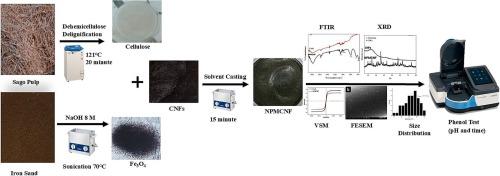基于Fe3O4/纳米碳纤维磁性复合材料的苏拉威西东南部西米浆绿色导电纸对苯酚的吸附
Q1 Environmental Science
Environmental Nanotechnology, Monitoring and Management
Pub Date : 2025-07-25
DOI:10.1016/j.enmm.2025.101090
引用次数: 0
摘要
研究了用Fe3O4纳米粒子(Fe3O4/CNFs)修饰碳纳米纤维(CNFs),以西米浆为吸附剂制备绿色导电磁性纳米复合纸。该纸是利用西米农民社区的西米纸浆废料合成的。为了生产纤维素纸,对西米纸浆进行了机械和化学处理,采用脱半纤维素和脱木质素技术。采用超声法将铁砂在8 M NaOH溶液中,在70℃条件下反应120 min合成Fe3O4。采用超声法在水中制备了Fe3O4/CNFs纳米复合材料。以西米纤维素和聚乙烯醇(PVA)为原料,经超声混合,再经溶剂铸造干燥制备纳米复合纸。通过x射线衍射(XRD)和傅里叶变换红外光谱(FTIR)对纸的相结晶度进行了评价。用紫外可见分光光度计在最大波长269 nm处考察了苯酚在磁性纸上的传感和吸附动力学性质。结果表明,在最佳pH = 7、接触时间为90 min的条件下,苯酚在磁性纸上的吸附符合Ho-McKay准二级吸附动力学,吸附量为3.15 mg/g。Fe3O4/CNFs磁性导电纸在吸附环境中酚类化合物方面具有广泛的应用前景。本文章由计算机程序翻译,如有差异,请以英文原文为准。

Green conductive paper derived from sago pulp of Southeast Sulawesi based on magnetic nanocomposite of Fe3O4/carbon nanofibers for phenol adsorption
A green conductive magnetic nanocomposite paper that has been synthesized by decorating carbon nanofibers (CNFs) with Fe3O4 nanoparticles (Fe3O4/CNFs) and mixed with sago pulp as phenol adsorbents has been investigated. The paper was synthesized using sago pulp waste from the sago farmer’s community. To produce cellulose paper, Sago pulp was treated mechanically and chemically through dehemicellulose and delignification techniques. Fe3O4 was synthesized by ultrasonication of iron sand in NaOH solution (8 M) for 120 min at 70 °C. The nanocomposite of Fe3O4/CNFs was prepared by ultrasonication Fe3O4 and CNFs in water. The nanocomposite paper was finally prepared by mixing sago’s cellulose and polyvinyl alcohol (PVA) with ultrasonication, followed by solvent casting drying. The phase crystallinity of the paper was evaluated via X-ray Diffraction (XRD) and Fourier Transform infrared (FTIR) spectroscopy. The phenol’s sensing and adsorption kinetic properties over the magnetic paper were examined using a UV–Vis spectrophotometer at a maximum wavelength of 269 nm. The result showed that the phenol was efficiently adsorbed on magnetic paper under an optimum pH of 7 at a contact time of 90 min. The adsorption followed Ho-McKay pseudo-second-order kinetics with adsorption capacity at an equilibrium of 3.15 mg/g. The magnetic and conductive paper of Fe3O4/CNFs should be extensively used in the adsorption of phenolic compounds in the environment.
求助全文
通过发布文献求助,成功后即可免费获取论文全文。
去求助
来源期刊

Environmental Nanotechnology, Monitoring and Management
Environmental Science-Water Science and Technology
CiteScore
13.00
自引率
0.00%
发文量
132
审稿时长
48 days
期刊介绍:
Environmental Nanotechnology, Monitoring and Management is a journal devoted to the publication of peer reviewed original research on environmental nanotechnologies, monitoring studies and management for water, soil , waste and human health samples. Critical review articles, short communications and scientific policy briefs are also welcome. The journal will include all environmental matrices except air. Nanomaterials were suggested as efficient cost-effective and environmental friendly alternative to existing treatment materials, from the standpoints of both resource conservation and environmental remediation. The journal aims to receive papers in the field of nanotechnology covering; Developments of new nanosorbents for: •Groundwater, drinking water and wastewater treatment •Remediation of contaminated sites •Assessment of novel nanotechnologies including sustainability and life cycle implications Monitoring and Management papers should cover the fields of: •Novel analytical methods applied to environmental and health samples •Fate and transport of pollutants in the environment •Case studies covering environmental monitoring and public health •Water and soil prevention and legislation •Industrial and hazardous waste- legislation, characterisation, management practices, minimization, treatment and disposal •Environmental management and remediation
 求助内容:
求助内容: 应助结果提醒方式:
应助结果提醒方式:


